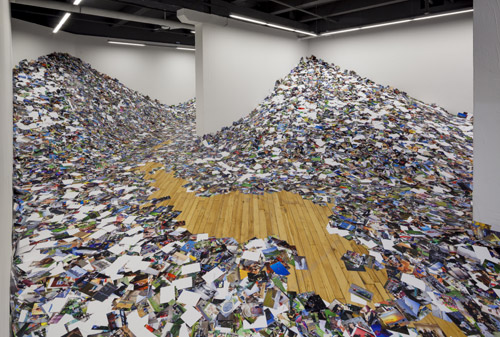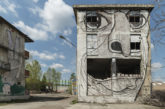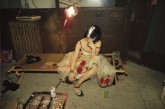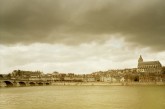Era il 1960 – ben prima, quindi, dell’invasione digitale – quando Borges descriveva una mappa in scala 1:1 che, sovrapponendosi e coincidendo perfettamente con lo spazio rappresentato, diventava inservibile. E così è accaduto: alle cose si sono sostituite le immagini delle cose, l’immaginario alla realtà. Oggi con fotocamere, smartphones, Google Maps e i social network assistiamo ad una vera e propria sovrappopolazione visiva. Il mondo si è moltiplicato, e questa mappa dell’Impero invece di orientare confonde. Ogni due minuti scattiamo più fotografie di quante ne siano state realizzate in tutto l’Ottocento. L’invenzione nel 1900 della prima consumer camera, la Kodak Brownie, segnò l’inizio dei Kodak moments e della fotografia di massa. Attualmente esistono oltre un miliardo di dispositivi in grado di produrre immagini, e il tempo necessario per la produzione e la condivisione continua a diminuire, dai pochi secondi di Instagram al tempo reale degli occhiali di Google (si veda l’articolo di Andrea Tinterri). Già nel 2011 le immagini su Facebook erano 10.000 volte di più di quelle presenti nella Library of Congress di Washington D.C., la più grande biblioteca al mondo, e oggi sono circa 140 miliardi, con 250 milioni di upload al giorno. Nello stesso anno Erik Kessels stampa in formato 10×15 l’equivalente dell’upload giornaliero su flickr, col quale riempie la galleria FOAM di Amsterdam. Il risultato è monumentale: i visitatori erano letteralmente sommersi da una montagna di immagini. Secondo Yahoo! in base al trend attuale entro il 2014 saranno realizzate 880 miliardi di fotografie, più di quanto ognuno di noi sia in grado di vedere in tutta la sua vita.
In questo surplus informativo tutto sembra già visto, già detto, già vissuto, come in un continuo déjà-vu. (…)

2013, Installation at Contact Gallery, Toronto
Photo: Toni Hafkensched
It was in 1960, well before the digital revolution, that Borges was describing a map which overlapped and coincided perfectly with the land it depicted and was therefore unusable. That fiction has since become our reality, as we live in a world where tangible objects have been substituted by images of those objects; with the invention of cameras, Google Maps, smartphones and social networks we are experiencing a visual overlap where the virtual and the concrete become interchangeable. Our world has multiplied and the Map of the Empire doesn’t direct us, but confuses us instead. Every two minutes we take more photos than our 19th Century counterparts ever did. Mass photography began with the Kodak moments and the invention of the Kodak Brownie in 1900, the first true consumer camera. Today there are over a billion devices able to take pictures and the time it takes to produce and share these images is rapidly diminishing, from the few seconds needed to upload them onto Instagram to the constant streaming achieved by using the new Google Glasses. Already in 2011, Facebook’s photo collection was 10,000 times bigger than the one at Washington’s Library of Congress, the largest library in the world. In 2013 the number of photos rose to 140 billion, with an estimated 250 million daily uploads1. Yahoo! predicts that if the production rate of photos continues with the present trend, there will be 880 billion pictures by 2014, more than is physically possible to view in a single lifetime2. 2013 is also the year that Erik Kessels chose to address this phenomenon; he printed the equivalent of the daily image upload on Flickr in a 10×15 format and filled Amsterdam’s FOAM gallery achieving staggering results, as visitors were literally submerged by dunes of images.
In this surplus of information, everything has already been said, seen and lived, creating a constant state of déjà-vu. (…)
Eleonora Roaro
D’ARS year 53/nr 215/autumn 2013 (abstract dell’articolo)




